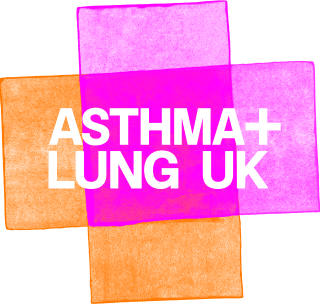Asthma treatment guidelines
Updated asthma guidelines from NICE (National Institute for Health and Care Excellence) recommend that:
-
everyone with asthma needs treatment with inhaled steroids
-
no one with asthma should only have a blue reliever inhaler.
Why you need asthma medicines
“Asthma medicines can make a big difference to your symptoms and could save your life if you have an asthma attack. It can feel frustrating being told you need to take medicines. But with the right treatments and support, most people with asthma can get on with their lives without asthma symptoms getting in the way. Dr Andy Whittamore, Asthma + Lung UK’s GP.
Asthma causes inflammation and swelling in your airways. This makes your airways more likely to react to asthma triggers. If something triggers your asthma symptoms, your airways get tight and narrow. This makes it harder to breathe.
If you have asthma, you need a steroid preventer medicine to prevent symptoms and a reliever medicine to treat symptoms and asthma attacks. You usually take these medicines through an inhaler. This helps the medicine get straight into the airways where it’s needed.
There are different types of inhalers. Some give you a puff of medicine. These are pressurised metered dose inhalers (pMDIs). If you have a pMDI inhaler use a spacer. Spacers help to get the medicine into the airways where it’s needed.
Some let you breathe in your asthma medicine. These are dry powder inhalers (DPIs) and soft mist inhalers. You do not need to use a spacer with a DPI.
You may have one combination inhaler with both medicines in, or two separate inhalers.
-
Steroid medicine keeps inflammation down in your airways. It’s the steroid medicine in your inhaler that lowers your risk of symptoms and asthma attacks. The steroids used in your inhaler are called corticosteroids. These are a copy of the steroids made naturally by our bodies.
-
Reliever medicine opens up your airways quickly if you have symptoms or an attack. Always carry your reliever inhaler with you so it’s ready to use when you need it. Your reliever inhaler may be your blue inhaler, your MART inhaler or your AIR inhaler.
Help your asthma medicines work well by:
-
doing physical activity
-
keeping to a healthy weight
-
avoiding your asthma triggers
-
getting vaccinations like the flu jab
-
quitting smoking if you smoke
Find out more about managing your asthma well.
When your medicines are working well
When your asthma medicines are working well, you can expect:
-
no asthma symptoms during the day
-
better sleep because asthma symptoms are not waking you up at night
-
less need for your reliever inhaler
-
to be able to get on with daily life, including exercise, without asthma symptoms getting in the way.
Even if your asthma is well controlled, never stop or cut down your asthma medicines before speaking to your GP or nurse. They can make sure you reduce treatments slowly and carefully. Always speak to your GP or nurse again if you think symptoms are coming back.” Dr Andy Whittamore, Asthma + Lung UK’s GP.
Do asthma medicines have side effects?
Most medicines have side effects but not everyone will get them. Some side effects are more common than others. Many listed on the patient information leaflet that comes with your medicine will be rare.
You can avoid some of the common side effects of asthma medicines, like a sore mouth or thrush, by rinsing your mouth and gargling after using your inhaler. If you use a pMDI (pressurised metered dose inhaler) using a spacer lowers your risk of side effects too.
If you’ve been taking high doses of steroid medicine in your inhaler over a long time, or taking steroid tablets long term, this can sometimes cause other side effects like easy bruising.
But remember that your asthma medicines lower your risk of an asthma attack so it’s important to keep taking them.
Always go for regular asthma reviews, so your GP can check that the steroids in your inhaler are at the lowest dose possible to keep you well and lower your risk of any side effects.
We answer common questions about asthma inhalers and treatments, including any worries about side effects.
Tell your GP surgery about any side effects you’re getting. There could be a simple way to reduce or treat the side effects, so you can carry on taking the medicine and getting the benefits for your asthma. Or your GP can talk to you about trying different treatments.” Dr Andy Whittamore, Asthma + Lung UK’s GP.
Starting asthma medicines
For adults and children over 12 diagnosed with asthma, the latest medical guidelines recommend using a special type of combination inhaler.
Your GP or nurse may ask you to use this combination inhaler:
-
only as needed if you get symptoms. This is because you have no, or very few, symptoms. Using your inhaler like this is known as an AIR treatment plan.
-
every morning and evening as prescribed, as well as when you get symptoms. This is because you have regular symptoms which are affecting your daily life, or waking you up at night. Using your inhaler like this is known as a MART treatment plan.
This type of combination inhaler contains:
-
an inhaled corticosteroid (ICS) to treat inflammation in your airways
-
a long-acting bronchodilator called formoterol, which can also open your airways quickly if you get symptoms or an asthma attack.
You do not need a separate blue reliever inhaler if you’re using this type of combination inhaler. This is because your inhaler contains formoterol, which works quickly as a reliever if you get symptoms.
A combination inhaler without formoterol cannot be used as a MART or AIR inhaler.
Preventer and reliever inhalers
Most people diagnosed with asthma used to be prescribed a steroid preventer inhaler and a blue reliever inhaler. This was previously recommended by medical guidelines.
-
A steroid preventer inhaler keeps down inflammation in your airways.
-
A blue reliever inhaler quickly relieves symptoms of an asthma attack.
These medicines work still well for many people with asthma and as long as your asthma is controlled you can keep using these inhalers.
But if you’re still getting symptoms, even though you’re using your steroid preventer or combination inhaler every day as prescribed, latest guidelines recommend a MART inhaler to help you control your symptoms better.
Increasing your asthma medicines
You may not need to increase your medicines. Your GP or nurse can first check if anything else could be making your asthma harder to manage. It can help to think about this before your appointment.
It could be that you are:
-
not taking your preventer or combination inhaler every day as prescribed
-
not using your inhaler in the best way
-
not getting the full benefits from your medicines because you smoke
-
exposed to asthma triggers like dust mites, mould and pollution.
Ask your GP or asthma nurse to update your asthma action plan with any changes to your medicines.
Whenever you start a new medicine, or you change your medicines, your GP or nurse should check how you’re getting on with the new medicines in 8 to 12 weeks.
Changing your treatment plan
If you’re managing your asthma well, but still getting asthma symptoms, your GP or nurse may change your treatment plan.
-
If you have been on an AIR treatment plan, your GP or nurse may move you to a MART plan. This means instead of taking your inhaler only when you get symptoms, you also take it every morning and evening to prevent the inflammation which is causing the symptoms.
-
If your symptoms are not well managed with a preventer and reliever plan, you may be moved onto a MART treatment plan.
Increasing the dose in your inhaler
If you’ve been on a low dose MART plan, and regularly need to take extra doses of your MART inhaler, or you’re still getting symptoms, your GP or nurse may increase the dose in your MART inhaler.
Trying an add-on treatment
An add-on treatment is a treatment you take alongside your usual asthma medicines.
Before trying an add-on treatment, your GP or nurse will do some simple tests:
-
a blood test to check if you have high levels of a blood cell called an eosinophil
-
a FeNO test to check levels of nitric oxide in your breath. This can be a sign that you have inflamed airways.
If you do not have high levels of blood eosinophils, or a high FeNO result, but you do need help managing your asthma, your GP may try add-on treatments.
Your GP or nurse may ask you to try either montelukast, or a medicine called LAMA (long-acting muscarinic receptor antagonist) alongside a moderate dose MART inhaler.
-
Montelukast is one of a group of medicines called leukotriene receptor antagonists or leukotriene modifiers. It helps prevent symptoms like swelling and inflammation in your airways, and also helps with seasonal allergies.
-
A LAMA relieves symptoms of asthma by relaxing the smooth muscle of the airways.
Medical guidelines recommend you try one of these add-on treatments for 8 to 12 weeks, alongside your MART inhaler. If it helps, you can carry on with it. If it does not help, you should be offered the other add-on treatment instead.
Referral to specialist care
Your GP or nurse may refer you to an asthma specialist if in spite of treatment
-
you’re getting lots of symptoms
-
you’ve had two or more asthma attacks needing oral steroids in a year
-
your asthma is not well controlled and tests show that you have high levels of eosinophils, or a high FeNO test result.
A referral to specialist care means you can get more tests and treatments to help you understand and manage your asthma better.
The specialist team can do tests to work out if you have severe asthma. They can see if you would benefit from biologic treatments.
Find out more about specialist asthma care.
Treating asthma attacks
Use your reliever inhaler if you have an asthma attack. This could be your:
-
blue reliever inhaler
-
AIR inhaler
-
MART inhaler.
Find out more about what to do in an asthma attack.
Always carry your reliever inhaler with you
Always carry your reliever inhaler with you so you can use it quickly if you get symptoms or have an attack.
If you do not have your reliever inhaler, and you’re struggling to breathe, call 999 straight away.
Can complementary therapies help asthma?
Some people find that some complementary therapies including breathing exercises, yoga and mindfulness help with their asthma.
If you do want to try complementary therapies, make sure you continue to take your usual asthma treatments.

Get support
Call our helpline for support with your condition. Get advice on your medicines, symptoms or travelling with a lung condition, or just call us to say hello.








